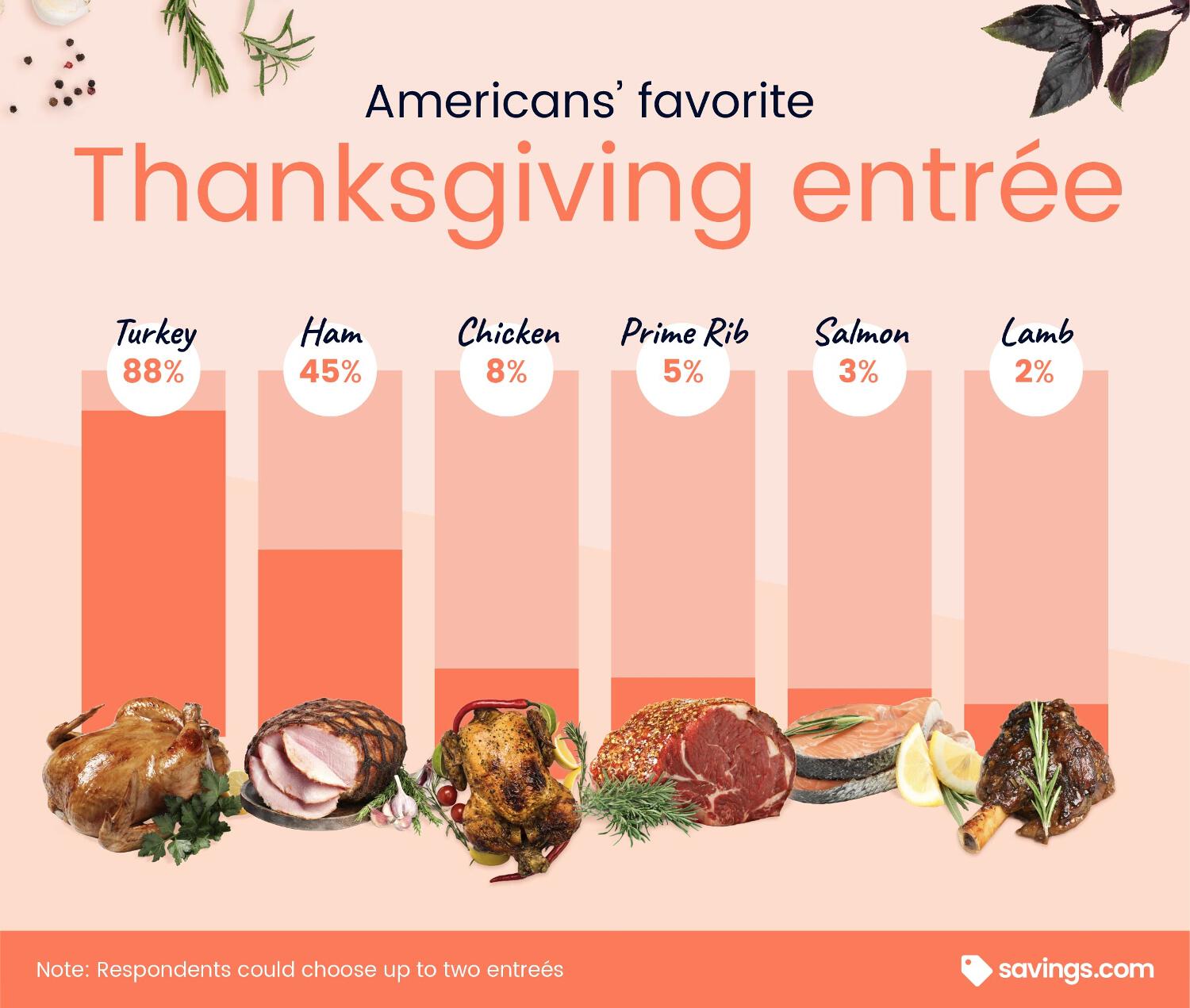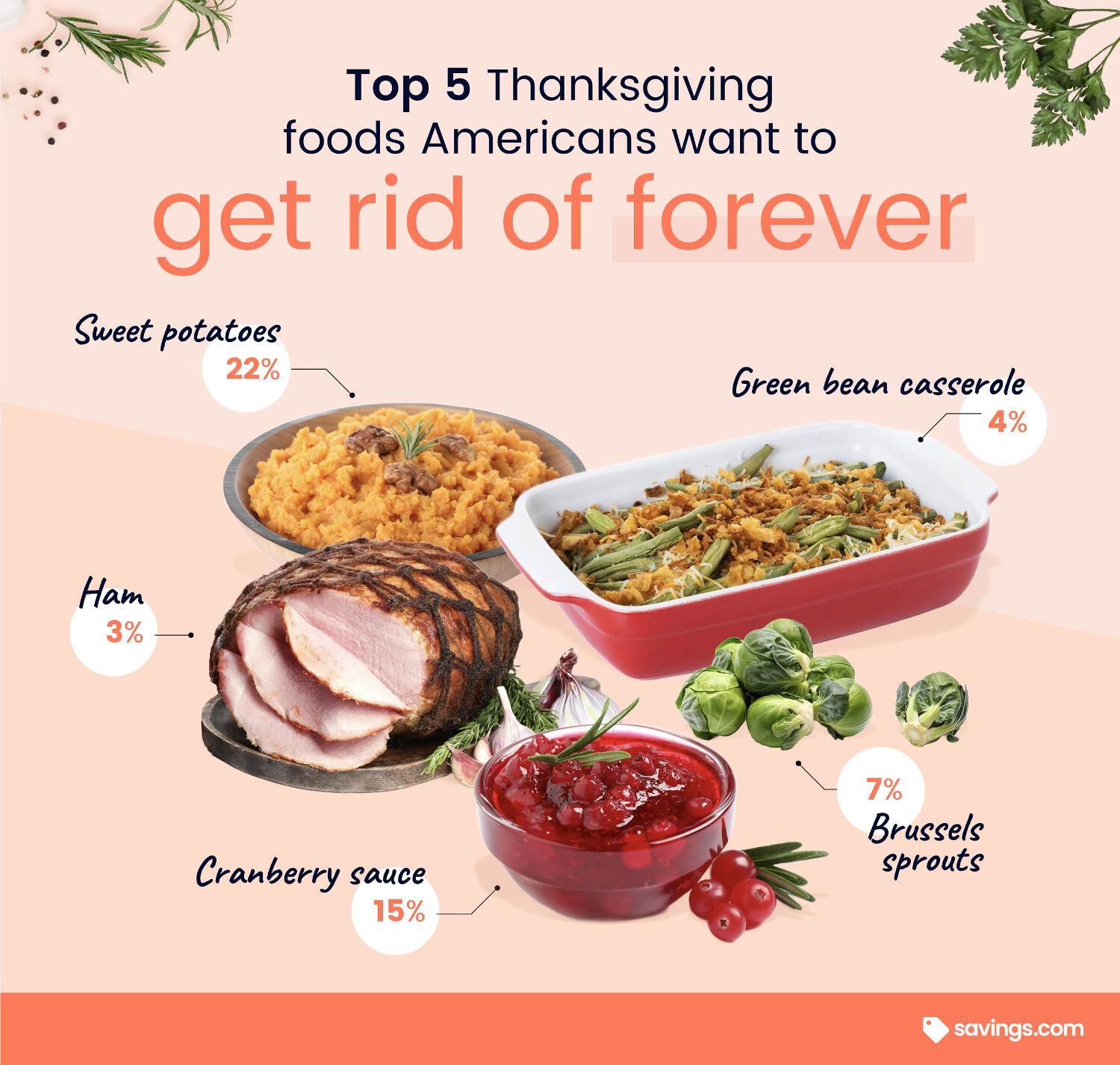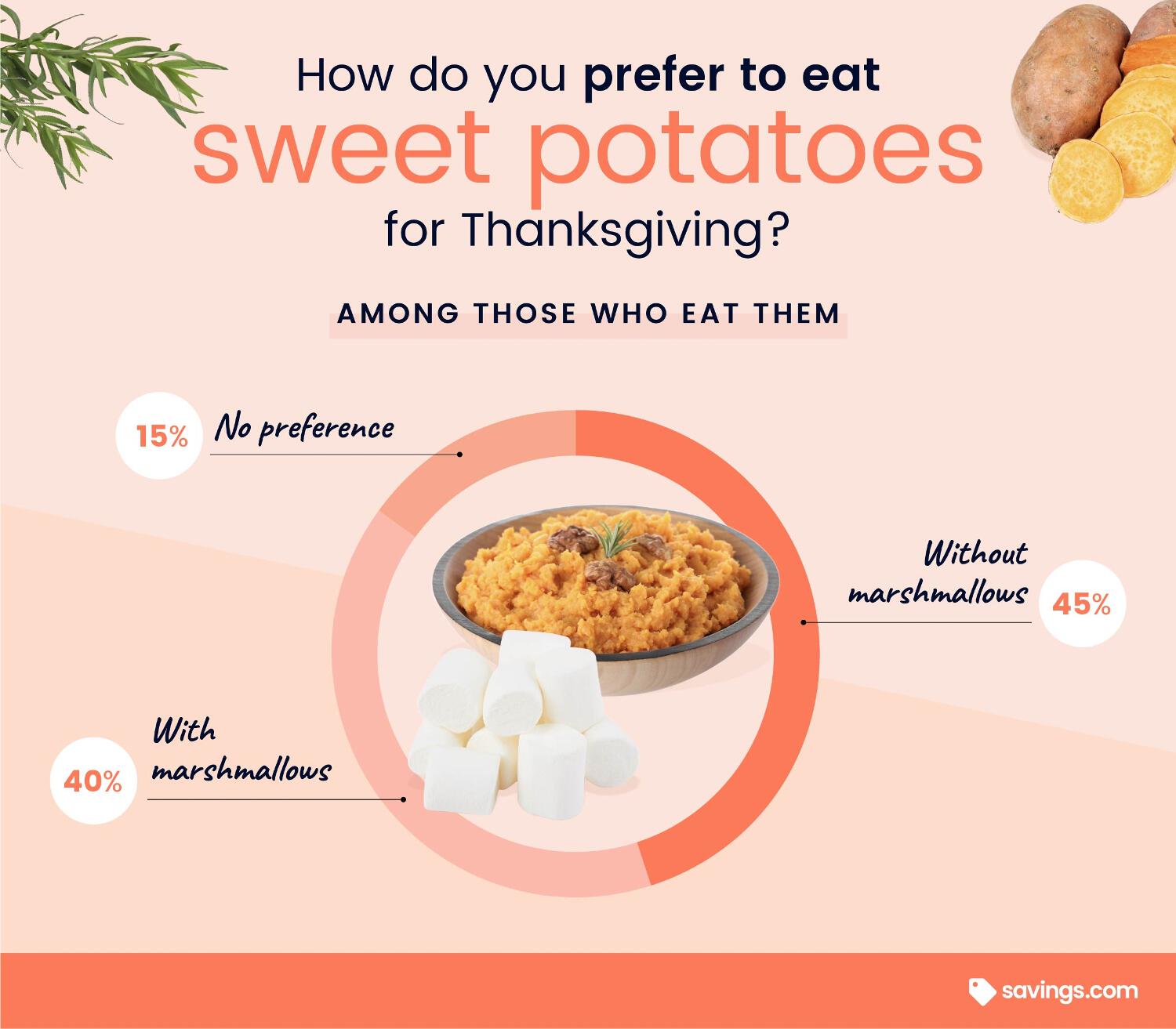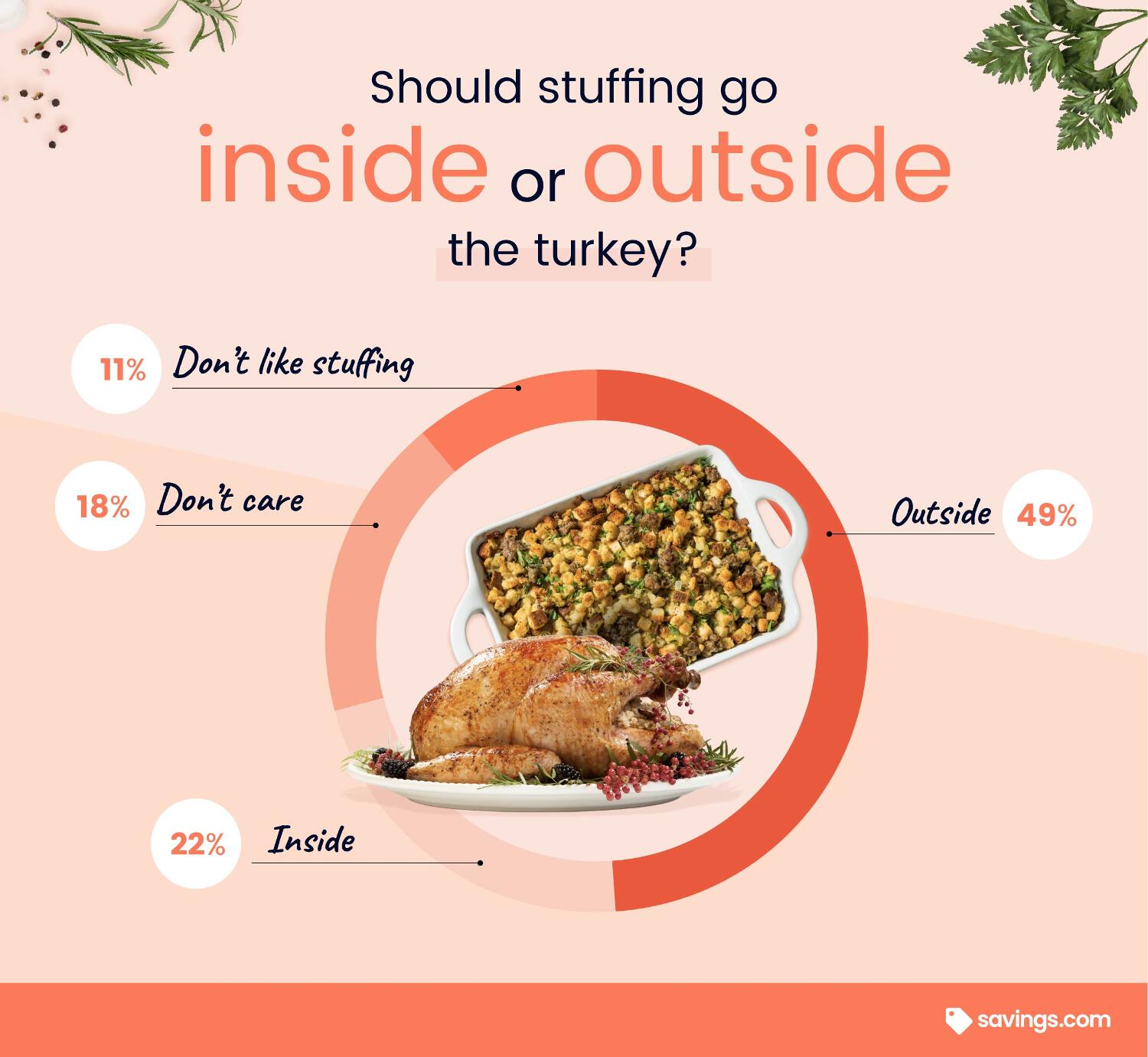
November 20, 2024
A new survey reveals the dishes you can cut from the menu to save money this holiday season.
Thanksgiving is America’s favorite non-denominational holiday. It’s a festive occasion marked by feasts, football, family…and occasional feuding. Tensions may run exceptionally high at the grown-ups’ table this election year, so Savings.com suggests an alternate arena to settle more playful disputes.
White meat or dark? Stuffing or spuds? Should we even call it Turkey Day? Keep conversation light with these collegial controversies and compare your results to ours. Hosts can also find practical guidance for deciding which foods to serve and which to skip.
We surveyed over 1,000 Americans regarding their Thanksgiving choices for main courses, side dishes, and desserts. The findings supply insight into evolving appetites and a roadmap for hosts hoping to avoid waste and cut inflated food bills. Read on, and prepare to get hungry.
Key Findings:
- Of the nearly 250 million adults eating turkey this holiday, two-thirds prefer white meat or have no preference, making turkey breast an acceptable (and cost-cutting) substitute for the whole bird.
- Mashed potatoes and stuffing are America's most beloved Turkey Day side dishes – 88 percent of adults chose one or both as must-haves, so be sure to serve these up.
- The top five foods Americans said should be banned from Thanksgiving are sweet potatoes, cranberry sauce, brussels sprouts, green bean casserole, and ham.
- The majority of Americans prefer fresh cranberry sauce over canned and want their stuffing cooked outside the turkey, but are narrowly divided on adding marshmallows to yams or leaving them plain.
- Seven in ten Americans are altering their Thanksgiving plans due to financial considerations, and 28 percent are staying home instead of traveling to cut costs. See full list below.
Talking Turkey: America’s Beloved Thanksgiving Entreé
George Washington suggested a national day of public thanksgiving in 1789, but Abraham Lincoln first set aside a November Thursday for celebration. Honest Abe was also the first to pardon a turkey intended for the table, but how did the gobbler get on the menu in the first place?
Some believe the tradition dates to the Pilgrims at Plymouth, though historians tell us that shellfish and venison were more likely main courses at the time. Others cite the popular myth that Ben Franklin endorsed the turkey over the eagle as our national bird. Most likely, the North American bird’s abundance, size, and affordability made it a popular choice. Once Norman Rockwell immortalized the platter, its place of honor on the table was secure.
Confirming that iconic status, our poll showed that 94 percent of Americans eat turkey on Thanksgiving, and 88 percent consider it an essential entrée for the day. Turkey was the most preferred main course for Thanksgiving dinner, garnering nearly double the support of runner-up ham.

Despite ham’s second-place finish, very few respondents said it was their favorite main course, so hosts looking to cut corners can serve only the bird without hearing much squawking from guests. Though turkey was the top choice from coast to coast, regional differences emerged among secondary entrees.
Ham proved particularly popular in the South, where "country ham" and "Virginia ham" are traditional staples. Southerners also showed the most support for chicken (likely fried). Out west in beef country, prime rib gained a boost. Salmon jumped onto more tables in the Northeast.
As the top attraction of the holiday table, nearly 50 million turkeys are consumed every Thanksgiving. The following day may be Black Friday for shoppers, but Thursday is dark for the gobblers.

On the subject of dark meat, despite generally being moister and more flavorful, only one-third of diners prefer those cuts of turkey. Half of Americans like white meat better, and 15 percent expressed no preference.
As more than two-thirds of turkey eaters choose white meat or have no preference, holiday hosts can save time and money by purchasing only the white meat breast. Buying one on the bone keeps calculations the same as a whole bird—approximately 24 ounces per person. When opting for a boneless turkey breast, only eight ounces per guest is necessary.
Now that the main course is decided, let's surround it with popular side dishes.
The Side Dish Showdown
Bird is the word defining Turkey Day meals, yet it’s not truly a feast until plates are piled high with trimmings. We found that Americans are picky about their side dishes—not only the selection but also how they’re prepared. Our survey presented an array of accompaniments and conducted a battle royale for a spot on the buffet.
Of the dozen side dishes considered, mashed potatoes, stuffing, and bread scored well -- so hosts should prepare to provide a major carbo load. Gravy and cranberry sauce rounded out the top five, supplying some much-needed moisture. Vegetables all fell to the bottom of the list.
| What side dish is a must-have at Thanksgiving? | |
|---|---|
| Mashed potatoes | 62% |
| Stuffing/dressing | 60% |
| Gravy | 34% |
| Rolls/bread | 28% |
| Cranberry sauce | 26% |
| Macaroni and cheese | 23% |
| Sweet potatoes | 22% |
| Green bean casserole | 17% |
| Corn | 9% |
| Brussels sprouts | 3% |
| Carrots | 2% |
| Sweet peas | 1% |
Side dish choices were broadly consistent nationwide, though stuffing and mashed potatoes swapped top spots in the South and Northeast. Cranberry sauce also cracked the top three in the Northeast, while Southerners elevated macaroni and cheese.

Not all menu decisions are so simple. Americans seemingly have a love-hate relationship with some garnishes, notably cranberry sauce and sweet potatoes. Though each received considerable support as an essential side dish, the tribe also voted them the top two foods to be banished from Thanksgiving Island.

This split opinion may stem from strong feelings about how the foods are prepared and presented. For instance, among the 68 percent of Americans who eat cranberry sauce at Thanksgiving, camps are narrowly divided between fresh cranberries and the cylindrical stuff from a can. Two-thirds of cranberry eaters would choose the fresh version or accept either, so that’s a host’s safest choice.

When it comes to sweet potatoes, the great controversy concerns whether to serve them with marshmallows or without. Some love marshmallows' added sweetness, while others believe they weirdly warp yams into dessert. Opinions were pretty evenly split among the 70 percent of Americans who partake in the dish.

Considering the slim margin and strong opinions, making one batch of each kind might be advisable – unless you live in the Northeast, where 83 percent of sweet potato eaters prefer the dish without marshmallows.
Our final side dish debate centered on Thanksgiving dressing.

Often called “stuffing" because it’s traditionally cooked inside the turkey, many Americans prefer the bready treat prepared separately from the bird. “Innies" believe their stuffing is more flavorful and moist, while many “outies" opt for a crisp outer layer and lower risk of bacterial contamination. Nine out of ten Americans eat stuffing at Thanksgiving, and most diners prefer it cooked outside the gobbler or have no preference.
Now that we’ve sorted the side dish situation, it’s finally time for dessert!
Pumpkin Pie Slices the Competition
Apple pie may be the quintessential American dessert, but its pumpkin cousin steals the spotlight on Thanksgiving. Unlike turkey, pumpkin was served at the first Thanksgiving celebration (though not in pie form) and remains an integral element to this day.
Dessert opinions generated the most passionate responses, with 95 percent expressing a preference for one pie over the others. As expected, pumpkin pie sliced up its competition – winning by more than a 2:1 margin over second-place apple.

Every region selected the same pies as their top three favorites (pumpkin, apple, pecan), and all chose pumpkin for the top slot. Apple was second in the Northeast and Midwest, while the South gave a silver medal to pecan. The West had a tie for the number two pie: apple and pecan (perhaps they should devise a recipe combining them!).
Carving Costs: Making Meals More Affordable
Following four brutal years of inflation that have driven food prices 20 percent higher, many families are seeking ways to keep costs under control. Seven out of 10 Americans are adjusting this year’s Thanksgiving plans to accommodate financial concerns.
| What changes will you be making to your Thanksgiving plans due to financial considerations? | |
|---|---|
| Staying home instead of traveling | 28% |
| Choosing store brands or discounted items | 23% |
| Preparing more homemade dishes instead of using pre-made options | 22% |
| Buying fewer or smaller portions of certain foods | 15% |
| Having a potluck-style meal to share the cost with others | 12% |
| Not hosting a holiday meal | 11% |
| Changing or limiting the menu | 6% |
| Inviting fewer people to dinner | 6% |
| Contributing less to a shared meal to save money | 4% |
| None of the above | 29% |
| *-Multiple choices allowed | |
Last year, 55 million Americans traveled over the Thanksgiving holiday, but more than a quarter who’d planned to do so this year have reconsidered because of costs. Eighteen percent (47M adults) are limiting menus, shrinking portions, cutting guest lists, or forfeiting hosting duties.
Here are some other top tips for taming the tally of upcoming holiday feasts:
Smart shopping: Setting a budget and sticking to shopping lists are wise strategies to avoid impulse buys or unnecessary expenditures. Buying non-perishable items in bulk for a discount and using the extra supplies throughout the year helps defer costs. Additionally, clipping coupons, seeking sales, and choosing store brands over name brands add up to significant savings.
Simplified menus: Beyond limiting dishes and considering turkey breasts instead of whole birds, try reducing reliance on pre-made foods. Making recipes from scratch and baking your own bread is often much cheaper and adds a personal touch. Pay attention to portion sizes – there’s no need to make mac and cheese for twenty if only ten people will be dining. Also, be mindful of leftovers; choose foods that keep well, and be sure to have a plan for stretching the extras or sending them home with guests.
Guest list review: Everyone loves a packed house during the holidays, and no family or friends should feel excluded, but tight finances can necessitate cutbacks. Limit guest lists, restrict travel, or share hosting duties. Make Thanksgiving a cooperative affair by asking guests to bring food or drinks; they'll appreciate being able to help. The wisest potluck strategy is to discuss or assign what everyone brings to avoid repetition (no celebration needs a whole table of marshmallow yams).
Conclusion
In an ideal world, every holiday gathering would overflow with endless dishes to sate every taste. Unfortunately, financial conditions find many tightening their belts ahead of the meal instead of merely loosening them afterward. One hundred eighty-six million adults and their families will make some sacrifices this season to cut costs, from restricting travel to limiting menus to hosting smaller affairs.
Despite limitations, the nation won’t allow inflation to dim the celebration of family and friends. Many Americans have myriad reasons to give thanks and enjoy warm Thanksgiving gatherings, simple or small. Savings.com is here to help you stretch every dollar and make the most of your holiday feast.
Our Data
In September 2024, Savings.com conducted an online survey of 1,049 Americans aged 18+. Our respondent pool ranged in age from 18 to 95, with a median age of 47. 51 percent were women and 49 percent men. 63 percent self-identified as White, 12 percent as Black, 6 percent as Asian, and 19 percent chose mixed, other, or preferred not to say. Our sample was drawn from across the country: 40 percent from the South, 27 percent from the West, 19 percent from the Midwest, and 14 percent from the Northeast (regions defined by the US Census Bureau).
